Supplier Selection and its Influence on Organizational Performance
VerifiedAdded on 2021/05/31
|6
|1822
|112
AI Summary
Contribute Materials
Your contribution can guide someone’s learning journey. Share your
documents today.
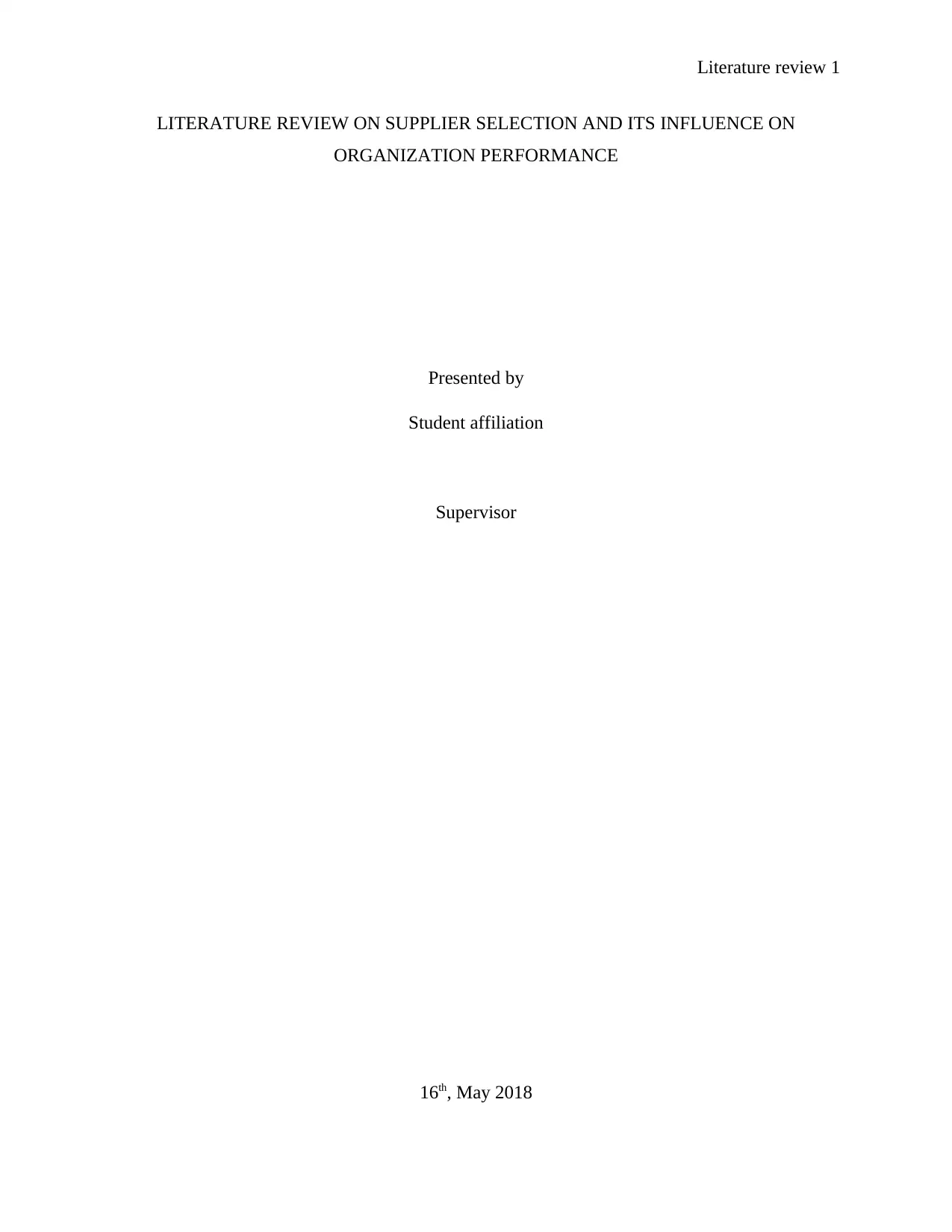
Literature review 1
LITERATURE REVIEW ON SUPPLIER SELECTION AND ITS INFLUENCE ON
ORGANIZATION PERFORMANCE
Presented by
Student affiliation
Supervisor
16th, May 2018
LITERATURE REVIEW ON SUPPLIER SELECTION AND ITS INFLUENCE ON
ORGANIZATION PERFORMANCE
Presented by
Student affiliation
Supervisor
16th, May 2018
Secure Best Marks with AI Grader
Need help grading? Try our AI Grader for instant feedback on your assignments.
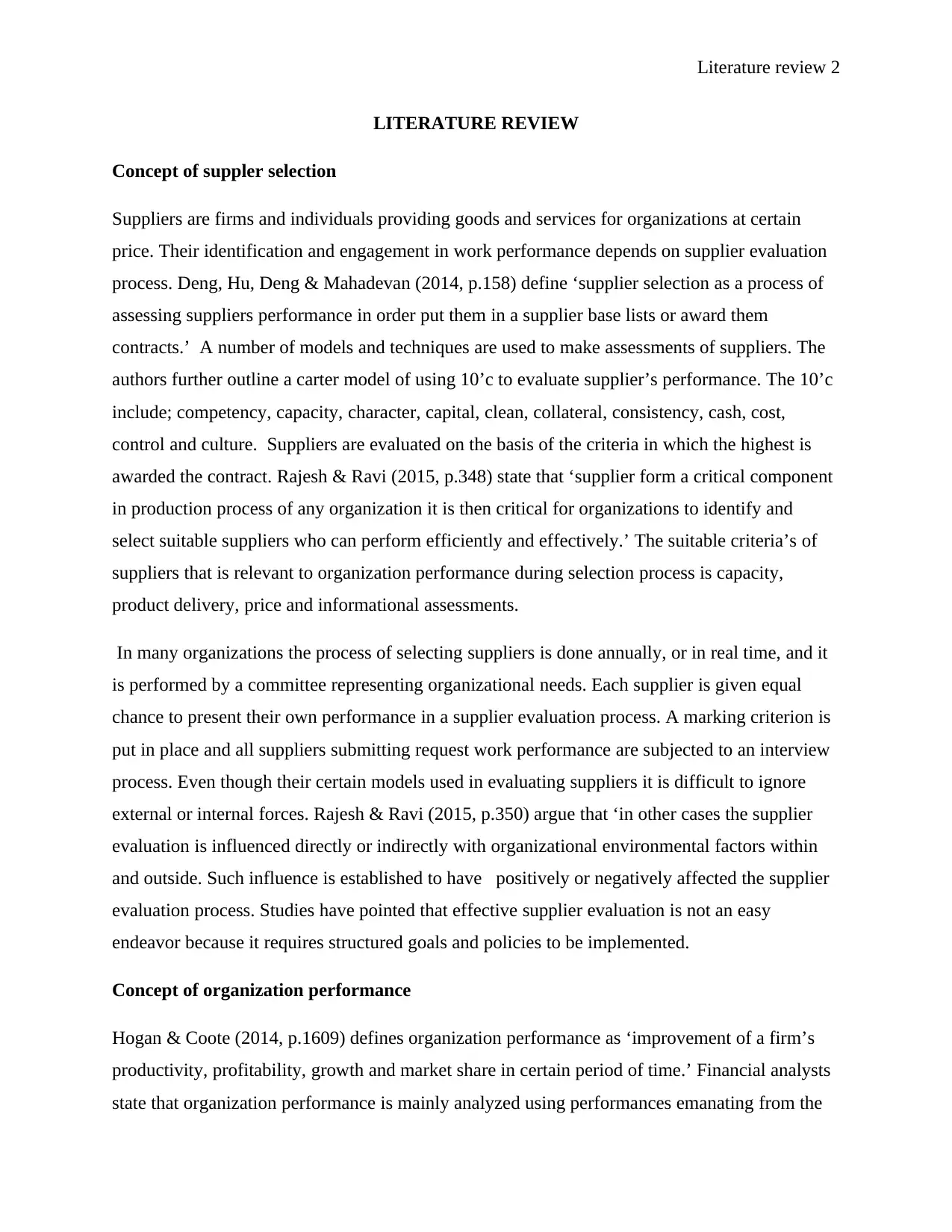
Literature review 2
LITERATURE REVIEW
Concept of suppler selection
Suppliers are firms and individuals providing goods and services for organizations at certain
price. Their identification and engagement in work performance depends on supplier evaluation
process. Deng, Hu, Deng & Mahadevan (2014, p.158) define ‘supplier selection as a process of
assessing suppliers performance in order put them in a supplier base lists or award them
contracts.’ A number of models and techniques are used to make assessments of suppliers. The
authors further outline a carter model of using 10’c to evaluate supplier’s performance. The 10’c
include; competency, capacity, character, capital, clean, collateral, consistency, cash, cost,
control and culture. Suppliers are evaluated on the basis of the criteria in which the highest is
awarded the contract. Rajesh & Ravi (2015, p.348) state that ‘supplier form a critical component
in production process of any organization it is then critical for organizations to identify and
select suitable suppliers who can perform efficiently and effectively.’ The suitable criteria’s of
suppliers that is relevant to organization performance during selection process is capacity,
product delivery, price and informational assessments.
In many organizations the process of selecting suppliers is done annually, or in real time, and it
is performed by a committee representing organizational needs. Each supplier is given equal
chance to present their own performance in a supplier evaluation process. A marking criterion is
put in place and all suppliers submitting request work performance are subjected to an interview
process. Even though their certain models used in evaluating suppliers it is difficult to ignore
external or internal forces. Rajesh & Ravi (2015, p.350) argue that ‘in other cases the supplier
evaluation is influenced directly or indirectly with organizational environmental factors within
and outside. Such influence is established to have positively or negatively affected the supplier
evaluation process. Studies have pointed that effective supplier evaluation is not an easy
endeavor because it requires structured goals and policies to be implemented.
Concept of organization performance
Hogan & Coote (2014, p.1609) defines organization performance as ‘improvement of a firm’s
productivity, profitability, growth and market share in certain period of time.’ Financial analysts
state that organization performance is mainly analyzed using performances emanating from the
LITERATURE REVIEW
Concept of suppler selection
Suppliers are firms and individuals providing goods and services for organizations at certain
price. Their identification and engagement in work performance depends on supplier evaluation
process. Deng, Hu, Deng & Mahadevan (2014, p.158) define ‘supplier selection as a process of
assessing suppliers performance in order put them in a supplier base lists or award them
contracts.’ A number of models and techniques are used to make assessments of suppliers. The
authors further outline a carter model of using 10’c to evaluate supplier’s performance. The 10’c
include; competency, capacity, character, capital, clean, collateral, consistency, cash, cost,
control and culture. Suppliers are evaluated on the basis of the criteria in which the highest is
awarded the contract. Rajesh & Ravi (2015, p.348) state that ‘supplier form a critical component
in production process of any organization it is then critical for organizations to identify and
select suitable suppliers who can perform efficiently and effectively.’ The suitable criteria’s of
suppliers that is relevant to organization performance during selection process is capacity,
product delivery, price and informational assessments.
In many organizations the process of selecting suppliers is done annually, or in real time, and it
is performed by a committee representing organizational needs. Each supplier is given equal
chance to present their own performance in a supplier evaluation process. A marking criterion is
put in place and all suppliers submitting request work performance are subjected to an interview
process. Even though their certain models used in evaluating suppliers it is difficult to ignore
external or internal forces. Rajesh & Ravi (2015, p.350) argue that ‘in other cases the supplier
evaluation is influenced directly or indirectly with organizational environmental factors within
and outside. Such influence is established to have positively or negatively affected the supplier
evaluation process. Studies have pointed that effective supplier evaluation is not an easy
endeavor because it requires structured goals and policies to be implemented.
Concept of organization performance
Hogan & Coote (2014, p.1609) defines organization performance as ‘improvement of a firm’s
productivity, profitability, growth and market share in certain period of time.’ Financial analysts
state that organization performance is mainly analyzed using performances emanating from the
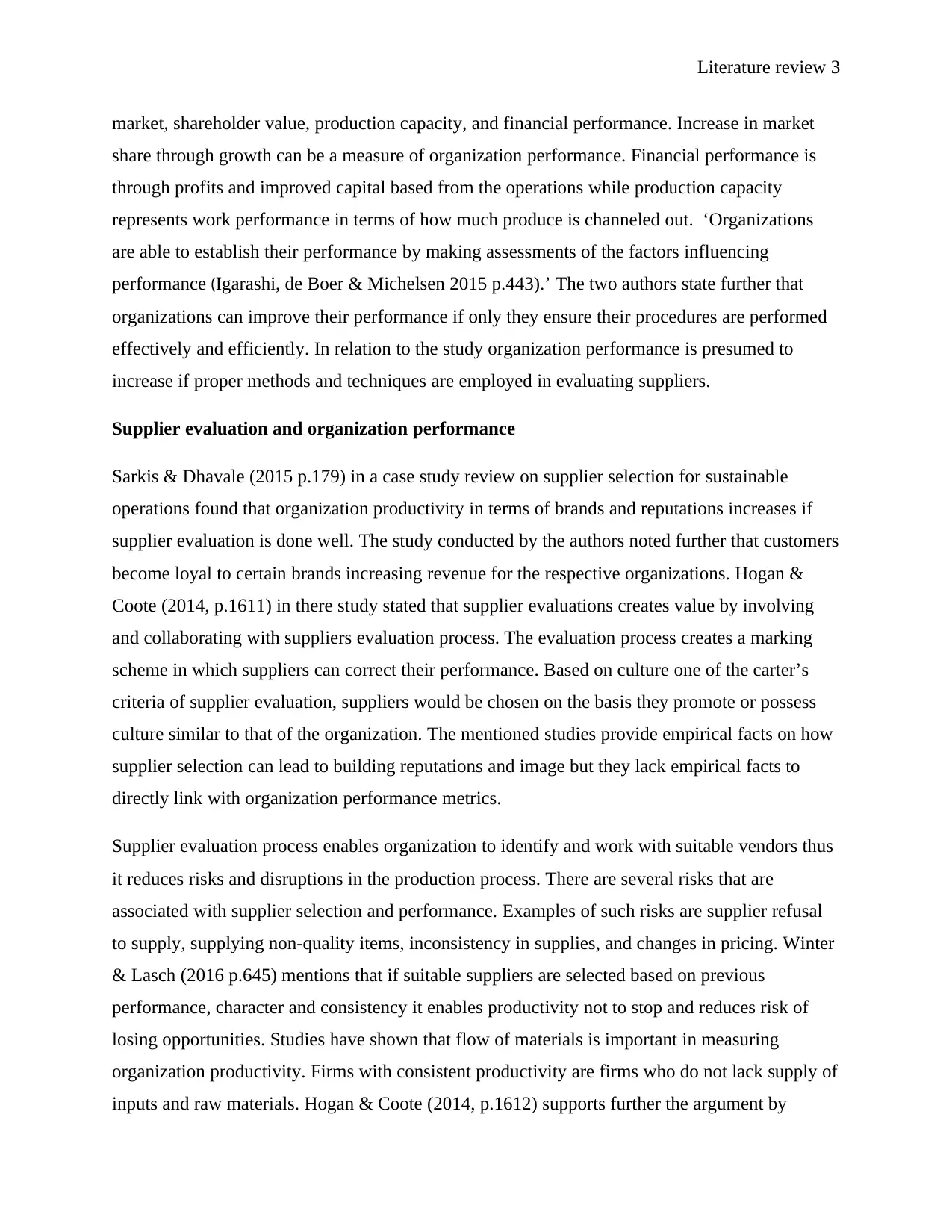
Literature review 3
market, shareholder value, production capacity, and financial performance. Increase in market
share through growth can be a measure of organization performance. Financial performance is
through profits and improved capital based from the operations while production capacity
represents work performance in terms of how much produce is channeled out. ‘Organizations
are able to establish their performance by making assessments of the factors influencing
performance (Igarashi, de Boer & Michelsen 2015 p.443).’ The two authors state further that
organizations can improve their performance if only they ensure their procedures are performed
effectively and efficiently. In relation to the study organization performance is presumed to
increase if proper methods and techniques are employed in evaluating suppliers.
Supplier evaluation and organization performance
Sarkis & Dhavale (2015 p.179) in a case study review on supplier selection for sustainable
operations found that organization productivity in terms of brands and reputations increases if
supplier evaluation is done well. The study conducted by the authors noted further that customers
become loyal to certain brands increasing revenue for the respective organizations. Hogan &
Coote (2014, p.1611) in there study stated that supplier evaluations creates value by involving
and collaborating with suppliers evaluation process. The evaluation process creates a marking
scheme in which suppliers can correct their performance. Based on culture one of the carter’s
criteria of supplier evaluation, suppliers would be chosen on the basis they promote or possess
culture similar to that of the organization. The mentioned studies provide empirical facts on how
supplier selection can lead to building reputations and image but they lack empirical facts to
directly link with organization performance metrics.
Supplier evaluation process enables organization to identify and work with suitable vendors thus
it reduces risks and disruptions in the production process. There are several risks that are
associated with supplier selection and performance. Examples of such risks are supplier refusal
to supply, supplying non-quality items, inconsistency in supplies, and changes in pricing. Winter
& Lasch (2016 p.645) mentions that if suitable suppliers are selected based on previous
performance, character and consistency it enables productivity not to stop and reduces risk of
losing opportunities. Studies have shown that flow of materials is important in measuring
organization productivity. Firms with consistent productivity are firms who do not lack supply of
inputs and raw materials. Hogan & Coote (2014, p.1612) supports further the argument by
market, shareholder value, production capacity, and financial performance. Increase in market
share through growth can be a measure of organization performance. Financial performance is
through profits and improved capital based from the operations while production capacity
represents work performance in terms of how much produce is channeled out. ‘Organizations
are able to establish their performance by making assessments of the factors influencing
performance (Igarashi, de Boer & Michelsen 2015 p.443).’ The two authors state further that
organizations can improve their performance if only they ensure their procedures are performed
effectively and efficiently. In relation to the study organization performance is presumed to
increase if proper methods and techniques are employed in evaluating suppliers.
Supplier evaluation and organization performance
Sarkis & Dhavale (2015 p.179) in a case study review on supplier selection for sustainable
operations found that organization productivity in terms of brands and reputations increases if
supplier evaluation is done well. The study conducted by the authors noted further that customers
become loyal to certain brands increasing revenue for the respective organizations. Hogan &
Coote (2014, p.1611) in there study stated that supplier evaluations creates value by involving
and collaborating with suppliers evaluation process. The evaluation process creates a marking
scheme in which suppliers can correct their performance. Based on culture one of the carter’s
criteria of supplier evaluation, suppliers would be chosen on the basis they promote or possess
culture similar to that of the organization. The mentioned studies provide empirical facts on how
supplier selection can lead to building reputations and image but they lack empirical facts to
directly link with organization performance metrics.
Supplier evaluation process enables organization to identify and work with suitable vendors thus
it reduces risks and disruptions in the production process. There are several risks that are
associated with supplier selection and performance. Examples of such risks are supplier refusal
to supply, supplying non-quality items, inconsistency in supplies, and changes in pricing. Winter
& Lasch (2016 p.645) mentions that if suitable suppliers are selected based on previous
performance, character and consistency it enables productivity not to stop and reduces risk of
losing opportunities. Studies have shown that flow of materials is important in measuring
organization productivity. Firms with consistent productivity are firms who do not lack supply of
inputs and raw materials. Hogan & Coote (2014, p.1612) supports further the argument by
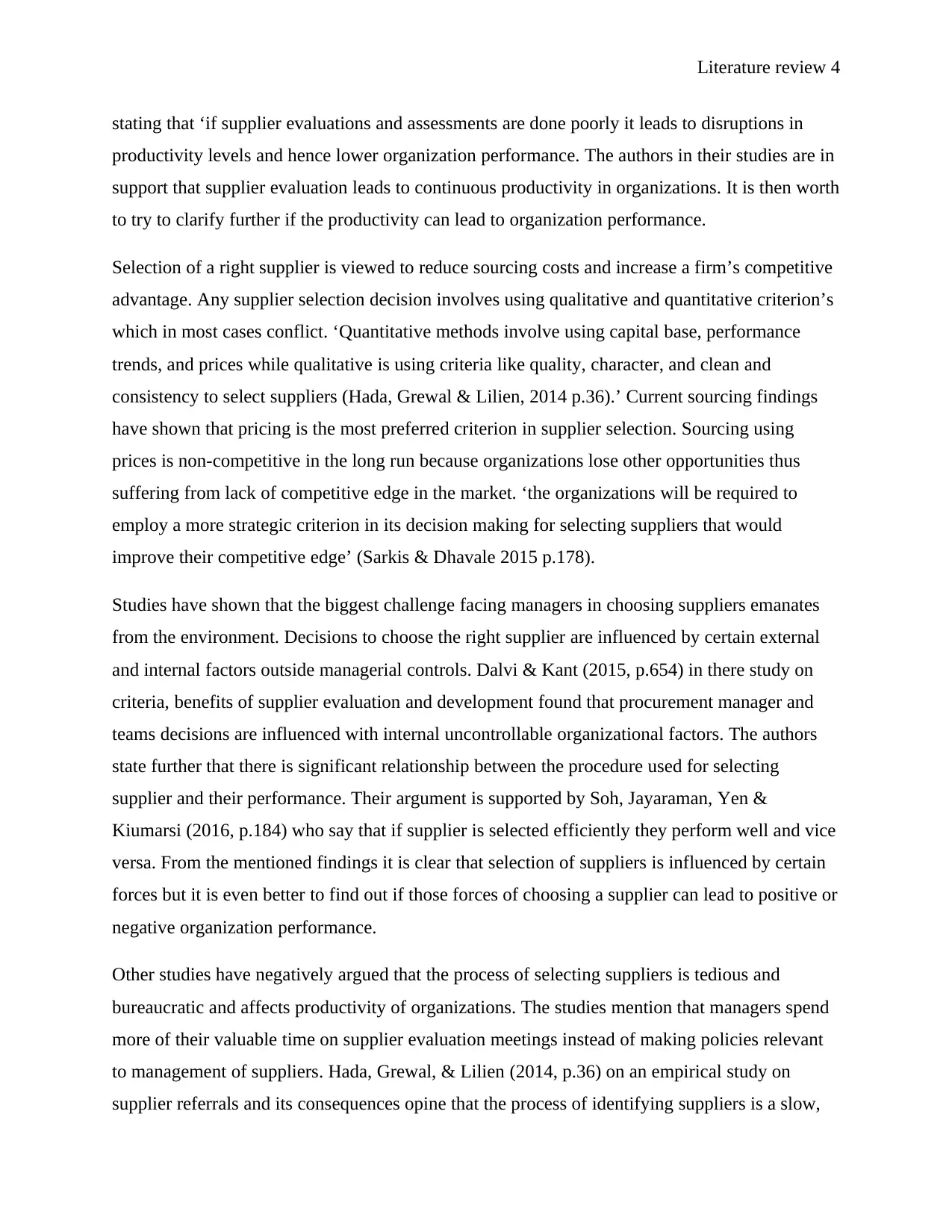
Literature review 4
stating that ‘if supplier evaluations and assessments are done poorly it leads to disruptions in
productivity levels and hence lower organization performance. The authors in their studies are in
support that supplier evaluation leads to continuous productivity in organizations. It is then worth
to try to clarify further if the productivity can lead to organization performance.
Selection of a right supplier is viewed to reduce sourcing costs and increase a firm’s competitive
advantage. Any supplier selection decision involves using qualitative and quantitative criterion’s
which in most cases conflict. ‘Quantitative methods involve using capital base, performance
trends, and prices while qualitative is using criteria like quality, character, and clean and
consistency to select suppliers (Hada, Grewal & Lilien, 2014 p.36).’ Current sourcing findings
have shown that pricing is the most preferred criterion in supplier selection. Sourcing using
prices is non-competitive in the long run because organizations lose other opportunities thus
suffering from lack of competitive edge in the market. ‘the organizations will be required to
employ a more strategic criterion in its decision making for selecting suppliers that would
improve their competitive edge’ (Sarkis & Dhavale 2015 p.178).
Studies have shown that the biggest challenge facing managers in choosing suppliers emanates
from the environment. Decisions to choose the right supplier are influenced by certain external
and internal factors outside managerial controls. Dalvi & Kant (2015, p.654) in there study on
criteria, benefits of supplier evaluation and development found that procurement manager and
teams decisions are influenced with internal uncontrollable organizational factors. The authors
state further that there is significant relationship between the procedure used for selecting
supplier and their performance. Their argument is supported by Soh, Jayaraman, Yen &
Kiumarsi (2016, p.184) who say that if supplier is selected efficiently they perform well and vice
versa. From the mentioned findings it is clear that selection of suppliers is influenced by certain
forces but it is even better to find out if those forces of choosing a supplier can lead to positive or
negative organization performance.
Other studies have negatively argued that the process of selecting suppliers is tedious and
bureaucratic and affects productivity of organizations. The studies mention that managers spend
more of their valuable time on supplier evaluation meetings instead of making policies relevant
to management of suppliers. Hada, Grewal, & Lilien (2014, p.36) on an empirical study on
supplier referrals and its consequences opine that the process of identifying suppliers is a slow,
stating that ‘if supplier evaluations and assessments are done poorly it leads to disruptions in
productivity levels and hence lower organization performance. The authors in their studies are in
support that supplier evaluation leads to continuous productivity in organizations. It is then worth
to try to clarify further if the productivity can lead to organization performance.
Selection of a right supplier is viewed to reduce sourcing costs and increase a firm’s competitive
advantage. Any supplier selection decision involves using qualitative and quantitative criterion’s
which in most cases conflict. ‘Quantitative methods involve using capital base, performance
trends, and prices while qualitative is using criteria like quality, character, and clean and
consistency to select suppliers (Hada, Grewal & Lilien, 2014 p.36).’ Current sourcing findings
have shown that pricing is the most preferred criterion in supplier selection. Sourcing using
prices is non-competitive in the long run because organizations lose other opportunities thus
suffering from lack of competitive edge in the market. ‘the organizations will be required to
employ a more strategic criterion in its decision making for selecting suppliers that would
improve their competitive edge’ (Sarkis & Dhavale 2015 p.178).
Studies have shown that the biggest challenge facing managers in choosing suppliers emanates
from the environment. Decisions to choose the right supplier are influenced by certain external
and internal factors outside managerial controls. Dalvi & Kant (2015, p.654) in there study on
criteria, benefits of supplier evaluation and development found that procurement manager and
teams decisions are influenced with internal uncontrollable organizational factors. The authors
state further that there is significant relationship between the procedure used for selecting
supplier and their performance. Their argument is supported by Soh, Jayaraman, Yen &
Kiumarsi (2016, p.184) who say that if supplier is selected efficiently they perform well and vice
versa. From the mentioned findings it is clear that selection of suppliers is influenced by certain
forces but it is even better to find out if those forces of choosing a supplier can lead to positive or
negative organization performance.
Other studies have negatively argued that the process of selecting suppliers is tedious and
bureaucratic and affects productivity of organizations. The studies mention that managers spend
more of their valuable time on supplier evaluation meetings instead of making policies relevant
to management of suppliers. Hada, Grewal, & Lilien (2014, p.36) on an empirical study on
supplier referrals and its consequences opine that the process of identifying suppliers is a slow,
Secure Best Marks with AI Grader
Need help grading? Try our AI Grader for instant feedback on your assignments.
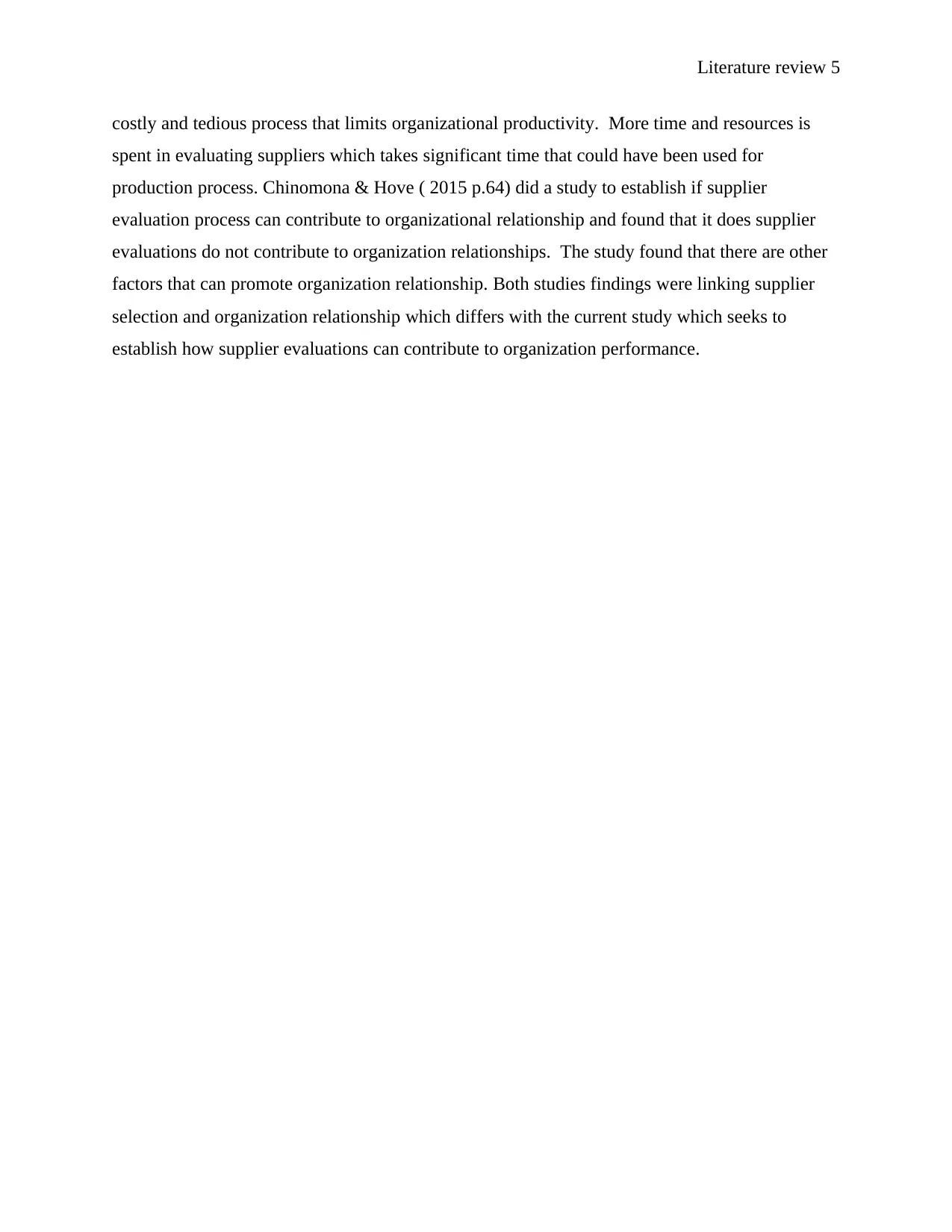
Literature review 5
costly and tedious process that limits organizational productivity. More time and resources is
spent in evaluating suppliers which takes significant time that could have been used for
production process. Chinomona & Hove ( 2015 p.64) did a study to establish if supplier
evaluation process can contribute to organizational relationship and found that it does supplier
evaluations do not contribute to organization relationships. The study found that there are other
factors that can promote organization relationship. Both studies findings were linking supplier
selection and organization relationship which differs with the current study which seeks to
establish how supplier evaluations can contribute to organization performance.
costly and tedious process that limits organizational productivity. More time and resources is
spent in evaluating suppliers which takes significant time that could have been used for
production process. Chinomona & Hove ( 2015 p.64) did a study to establish if supplier
evaluation process can contribute to organizational relationship and found that it does supplier
evaluations do not contribute to organization relationships. The study found that there are other
factors that can promote organization relationship. Both studies findings were linking supplier
selection and organization relationship which differs with the current study which seeks to
establish how supplier evaluations can contribute to organization performance.
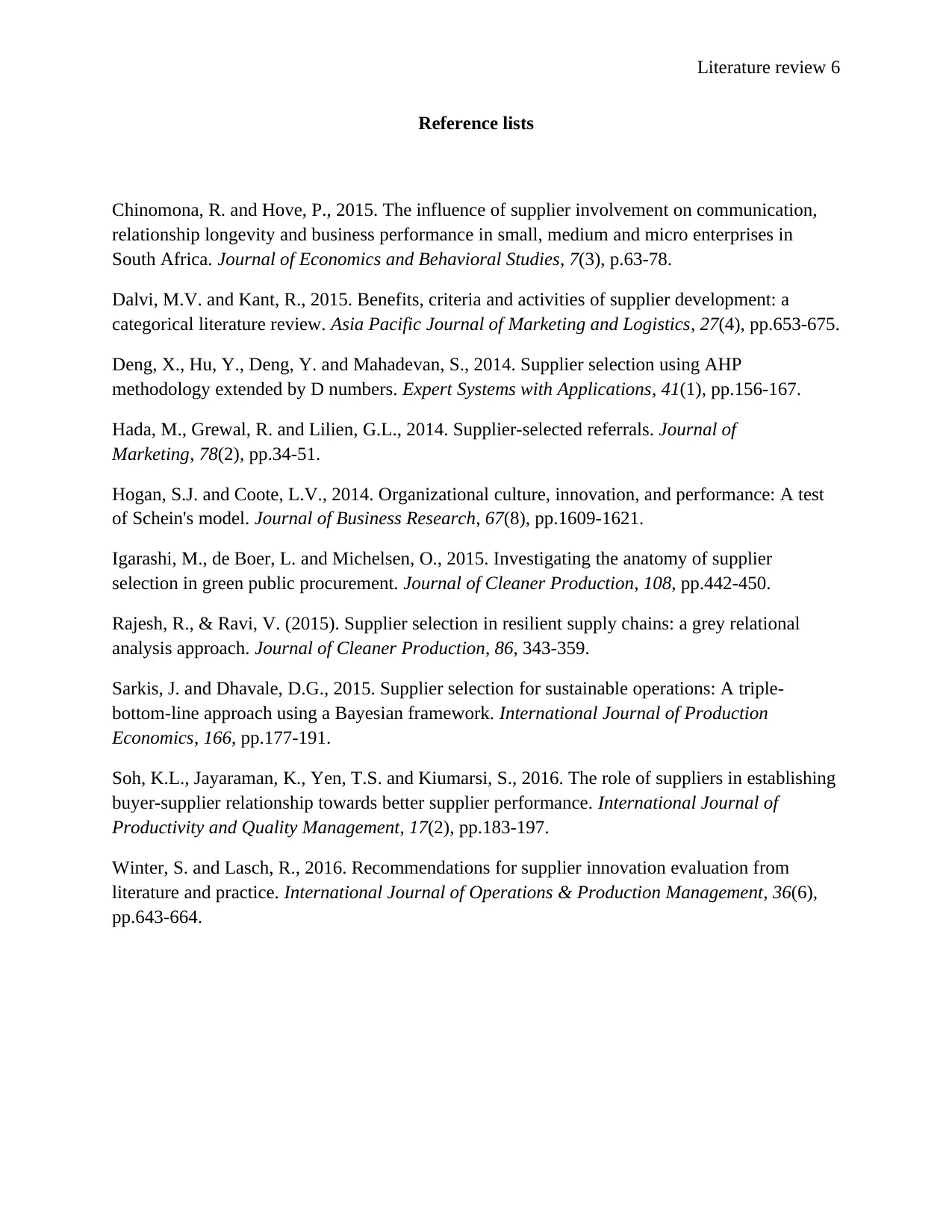
Literature review 6
Reference lists
Chinomona, R. and Hove, P., 2015. The influence of supplier involvement on communication,
relationship longevity and business performance in small, medium and micro enterprises in
South Africa. Journal of Economics and Behavioral Studies, 7(3), p.63-78.
Dalvi, M.V. and Kant, R., 2015. Benefits, criteria and activities of supplier development: a
categorical literature review. Asia Pacific Journal of Marketing and Logistics, 27(4), pp.653-675.
Deng, X., Hu, Y., Deng, Y. and Mahadevan, S., 2014. Supplier selection using AHP
methodology extended by D numbers. Expert Systems with Applications, 41(1), pp.156-167.
Hada, M., Grewal, R. and Lilien, G.L., 2014. Supplier-selected referrals. Journal of
Marketing, 78(2), pp.34-51.
Hogan, S.J. and Coote, L.V., 2014. Organizational culture, innovation, and performance: A test
of Schein's model. Journal of Business Research, 67(8), pp.1609-1621.
Igarashi, M., de Boer, L. and Michelsen, O., 2015. Investigating the anatomy of supplier
selection in green public procurement. Journal of Cleaner Production, 108, pp.442-450.
Rajesh, R., & Ravi, V. (2015). Supplier selection in resilient supply chains: a grey relational
analysis approach. Journal of Cleaner Production, 86, 343-359.
Sarkis, J. and Dhavale, D.G., 2015. Supplier selection for sustainable operations: A triple-
bottom-line approach using a Bayesian framework. International Journal of Production
Economics, 166, pp.177-191.
Soh, K.L., Jayaraman, K., Yen, T.S. and Kiumarsi, S., 2016. The role of suppliers in establishing
buyer-supplier relationship towards better supplier performance. International Journal of
Productivity and Quality Management, 17(2), pp.183-197.
Winter, S. and Lasch, R., 2016. Recommendations for supplier innovation evaluation from
literature and practice. International Journal of Operations & Production Management, 36(6),
pp.643-664.
Reference lists
Chinomona, R. and Hove, P., 2015. The influence of supplier involvement on communication,
relationship longevity and business performance in small, medium and micro enterprises in
South Africa. Journal of Economics and Behavioral Studies, 7(3), p.63-78.
Dalvi, M.V. and Kant, R., 2015. Benefits, criteria and activities of supplier development: a
categorical literature review. Asia Pacific Journal of Marketing and Logistics, 27(4), pp.653-675.
Deng, X., Hu, Y., Deng, Y. and Mahadevan, S., 2014. Supplier selection using AHP
methodology extended by D numbers. Expert Systems with Applications, 41(1), pp.156-167.
Hada, M., Grewal, R. and Lilien, G.L., 2014. Supplier-selected referrals. Journal of
Marketing, 78(2), pp.34-51.
Hogan, S.J. and Coote, L.V., 2014. Organizational culture, innovation, and performance: A test
of Schein's model. Journal of Business Research, 67(8), pp.1609-1621.
Igarashi, M., de Boer, L. and Michelsen, O., 2015. Investigating the anatomy of supplier
selection in green public procurement. Journal of Cleaner Production, 108, pp.442-450.
Rajesh, R., & Ravi, V. (2015). Supplier selection in resilient supply chains: a grey relational
analysis approach. Journal of Cleaner Production, 86, 343-359.
Sarkis, J. and Dhavale, D.G., 2015. Supplier selection for sustainable operations: A triple-
bottom-line approach using a Bayesian framework. International Journal of Production
Economics, 166, pp.177-191.
Soh, K.L., Jayaraman, K., Yen, T.S. and Kiumarsi, S., 2016. The role of suppliers in establishing
buyer-supplier relationship towards better supplier performance. International Journal of
Productivity and Quality Management, 17(2), pp.183-197.
Winter, S. and Lasch, R., 2016. Recommendations for supplier innovation evaluation from
literature and practice. International Journal of Operations & Production Management, 36(6),
pp.643-664.
1 out of 6
Related Documents
Your All-in-One AI-Powered Toolkit for Academic Success.
+13062052269
info@desklib.com
Available 24*7 on WhatsApp / Email
![[object Object]](/_next/static/media/star-bottom.7253800d.svg)
Unlock your academic potential
© 2024 | Zucol Services PVT LTD | All rights reserved.




